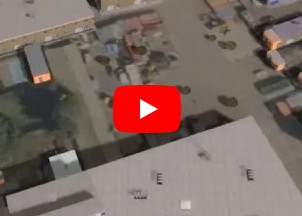Breach (Water Overlay)
A Breach area can be used to simulate a breach in a levee.
A breach area can be defined via the BREACH_HEIGHT attribute. It can have an input area or external area with a water body outside of the hydrological model. Water can flow through the breach form the input (or external area) into the breach area just behind the levee and vise versa.
Options
- The breach can grow over time, based on its initial width and the critical speed at which water may flow, see [Breach_growth_formula_(Water_Overlay)]. If a BREACH_WIDTH is defined, the breach's polygon is intersected with a circle emanating from the centerpoint of the polygon. It is only in that intersection, dubbed the "active breach", that water will flow in from the simulated external water body. The radius of the circle defining the intersection will expand as water flows, based on the critical speed of the water as defined in the BREACH_SPEED attribute. All cells in the active breach are considered directly adjacent to the external water body.
The terrain covered by the entire breach area is considered lowered to the height defined by its BREACH_HEIGHT attribute, even if the active breach does not extend across the entirety of the breach area.
Water flowing through or across a breach will flow in the direction defined by the BREACH_ANGLE attribute, regardless of whether the water flowed onto the breach from elsewhere in the water model, or from the simulated external water body. If no BREACH_ANGLE is defined, water can flow in any direction.
If no critical speed is defined, the active breach will never grow. If no width is defined, the width is assumed to be very large, creating an intersection exactly the size of the polygon.
| Icon | Key | Unit | Range | Description | Default value |
|---|---|---|---|---|---|
| |
BREACH_HEIGHT | m + datum | The new terrain height at the location of the breach. | n/a | |
| |
BREACH_WIDTH | m | The initial width of the breach. | 10000 | |
| |
BREACH_ANGLE | geo angle (0-360°) | -1.7976931348623157E308 to 1.7976931348623157E308 | The angle at which water flows out through the breach. | n/a |
| |
BREACH_SPEED | m/s | The critical speed factor in the breach width grow-formula (e.g. 0.2 for sand and 0.5 for clay). | n/a | |
| |
BREACH_INPUT_AREA | ID of an Area | The Area item representing the influx area for the breach. | none | |
| |
EXTERNAL_SURFACE_LEVEL | m + datum | The height of the bottom of the external water body behind the breach. The lowest level the external water level can lower to. | 0 | |
| |
EXTERNAL_WATER_LEVEL | m + datum | The water level of the external water body behind the breach. The initial level the water level is set to. | 0 | |
| |
EXTERNAL_AREA | m² | The surface area of the external water body behind the breach. The larger the external water body, the more water can flow from it (or into it), and the smaller the effect of the inflow or outflow of water on the external water level. When provided with a second value, this key will also define a bottom area for the external water body, transforming its cross-section from a rectangle to a trapezoid. | n/a |
Notes
- Water on a breach area is automatically spread across the entire breach area equally.
How-to's
- How to add a breach with external area manually
- How to add a breach with input area manually
- How to import a breach with input area
- How to set dynamic breach height
- How to visualize multiple sequential breaches (Water Overlay)





